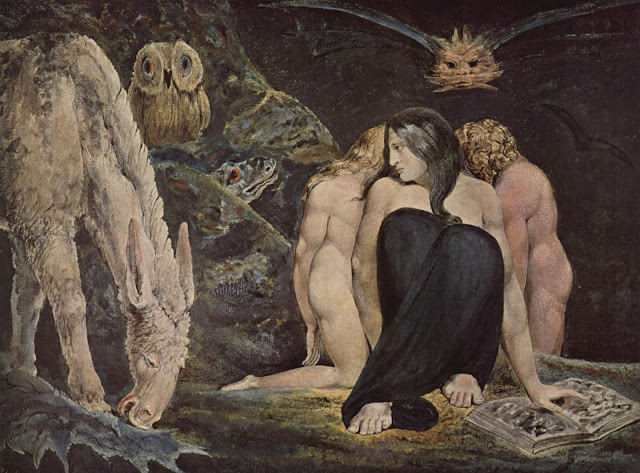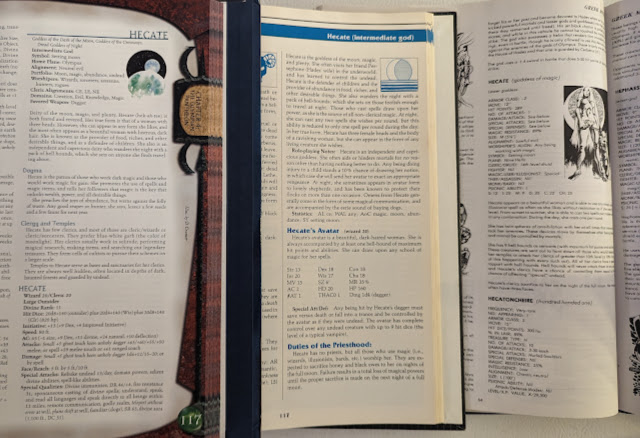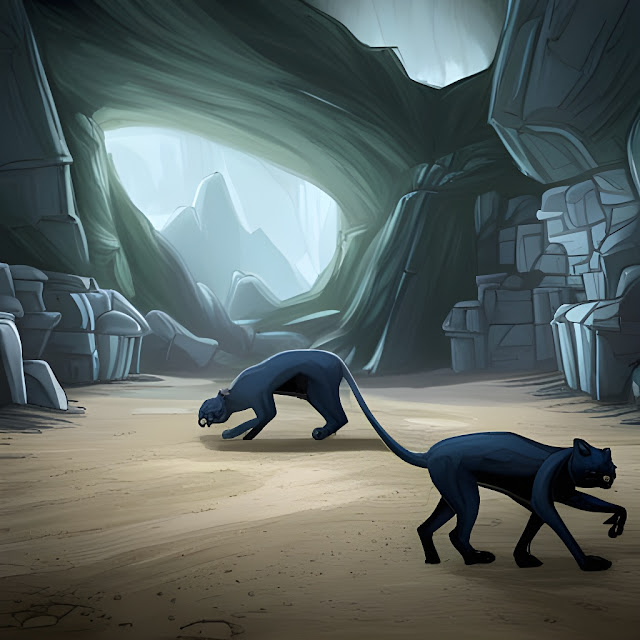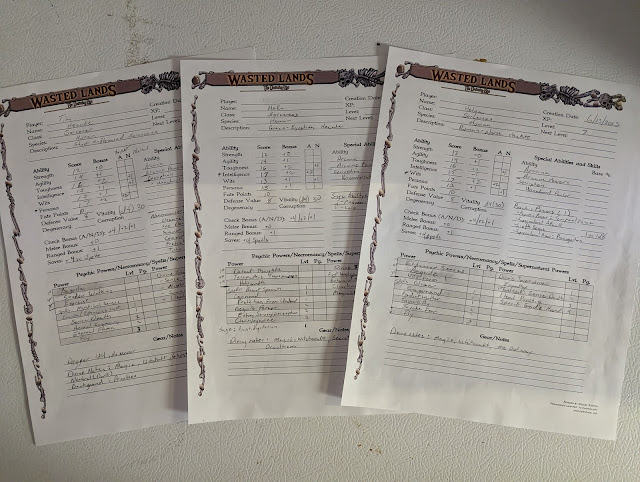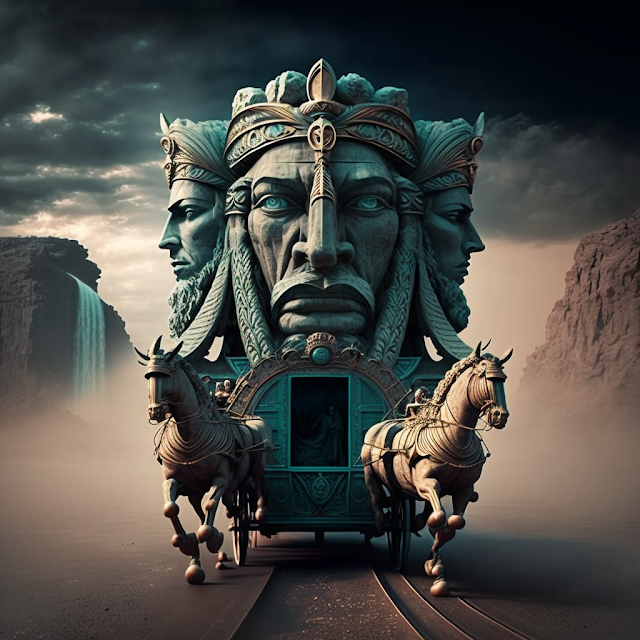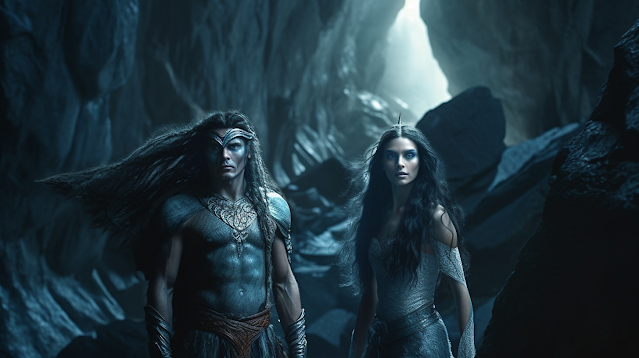Trying out a few things today.
First, I wanted to play-test a Sorcerer character, which is the Wasted Lands equivalent of the Witch from NIGHT SHIFT. In particular, I wanted to try out Hecate since I had already done Ereshkigal, even though I knew they shared certain similarities.
Secondly, I wanted to do Hecate because she is the first focal point of my new series on the Deities & Demigods II project/feature here.
Thirdly, and related to both points above I wanted to work out how my Heka (the Hecate of my Grecco-Egyptian myths) and Helga (the Hecate of my Roman-Norse myths) would work out.
And lastly, I wanted to try out the Divine Touchstones feature of this game. As it turns out, this feature makes all the difference in the world.
The Character: Hecate
For my second (and third and fourth) character, I am choosing Hecate, the goddess of witches, magic, the crossroads, and ghosts. She has been a favorite for a long time. She will also be the first Goddess I cover for my D&DGII project.
Hecate is a Sorceress in the Wasted Lands, no doubt. Well...some doubt. While her main deal is magic, she also has that aspect of Ghosts. In the end, I stuck with Sorceress and found a nice way to add the spooky stuff I wanted.
HecateClass: Sorceress (Persona Aspect)
Level: 7
Species: Human
Alignment: Dark Neutral
Abilities
Strength: 12 (0)
Agility: 14 (+1)
Toughness: 16 (+2) N +1
Intelligence: 15 (+1) N +1
Wits: 13 (+1)
Persona: 17 (+2) A +2
Fate Points: 10
Defense Value: 8
Vitality: 5 (d6)
Degeneracy:
Corruption:
Check Bonus (A/N/D): +4/+2/+1
Melee Bonus: +0
Ranged Bonus: +1
Saves: +4 to Magic based
Special Abilities
Arcana, Arcane Powers
Corruption
- Unnatural Parlor
Divine Touchstones
1st: Sense Ghosts
2nd: First Level Spell: Nightvision
3rd: Summon Hellhound
4th: Class level: Necromancer (1 level)
Necromancer (Divine Touchstone 4th)
Channel the Dead 22%
See Dead People
Summon the Dead 15%
Command (Spirits)
Protection from Undead
Turn Undead 20%
Spells
1st: Mystical Senses, Create/Extinguish Light, Sense Death
2nd: Animal Summoning, Eternal Flame
3rd: Fly
Arcane Powers
1st: Beguile
4th: Shadow Walking
7th: Exorcist
Divine Notes: Magic, Witchcraft, Crossroads, Ghosts
Background: Priestess
Gear
Dagger: 1d4
This version of Hecate is the Greek Goddess of magic, witches, ghosts and the crossroads. I leaned into the last two to give her powers over spirits and undead. She gains her Divine Touchstones as part of significant aspects in her adventuring career. Sense Ghosts would be something that came to her naturally along with Nightvision, she is also the Goddess of the Night. Giving her a level for her 4th Divine touchstone was really what sold me on the touchstones. If she wants another level then she will need a higher-level touchstone to get it.
This is really what sets Wasted Lands apart from other gritty Swords & Sorcery games.
It is also what helps set one character apart from another.
Heka and Helga are by definition just other versions of Hecate with something a little different. What is that something? Well here it is the arcane powers they get, but mostly it is the Divine Touchstones they earn.
For these next two characters I am keeping the base stats all the same. Human, 7th level Sorceress. But the differences now come from the spells, Arcane powers, the Divine Touchstones. One note since Sorcerers can choose their Aspect between Intelligence, Wits, and Persona, I picked different ones for each.
The Character: Heka
Heka is the Hecate of the Greeco-Egyptian mythology. While she is not a goddess that research into the Ptolemaic dynasty existed and would have worshiped (like Serapis or even later Hermes Trismegistus), she could have been in a D&D-like world.
In this mythology, Heka is more focused on the learning aspect of magic and is the goddess of Dark Secrets. Her relationship with Isis is the same as that of Ishtar with Ereshkigal. Dark and Light sisters. So for this, I switched her Aspect to Intelligence.
Like Hecate, Isis is connected to the underworld, so Heka would also be an underworld guardian and more of a protector of occult secrets. While this could lead to "Wisdom" and "Wits" I felt intelligence was the better choice. I have also always felt that Isis was one of the more intelligent gods in any myth.
HekaClass: Sorceress (Intelligence Aspect)
Level: 7
Species: Human
Alignment: Neutral
Abilities
Strength: 12 (0)
Agility: 14 (+1)
Toughness: 16 (+2) N +1
Intelligence: 17 (+2) A +2
Wits: 13 (+1)
Persona: 15 (+1) N +1
Fate Points: 10
Defense Value: 8
Vitality: 5 (d6)
Degeneracy:
Corruption:
Check Bonus (A/N/D): +4/+2/+1
Melee Bonus: +0
Ranged Bonus: +1
Saves: +4 to Magic based
Special Abilities
Arcana, Arcane Powers
Corruption
- Uncomfortable Aura
Divine Touchstones
1st: First Level Spell: Read Languages
2nd: Enhanced Senses
3rd: Class level: Sage (1 level)
4th: 1 level of Necromancer
Sage (Divine Touchstone 3rd)
Lore: 27%
Mesmerize Others: 10%
Spells: 1st Level: Prestidigitation
Spells
1st: Beast Speech, Command, Protection from Undead
2nd: Beguile Person, Extra Sensory Perception
3rd: Clairvoyance
Arcane Powers
1st: Detect Thoughts
4th: Telepathic Transmission
7th: Polymath
Divine Notes: Magic, Witchcraft, the Dead, Occultism
Background: Priestess
Gear
Dagger: 1d4
This version of Hecate combines part of the concept of Isis. So her connections to magic and the underworld are the same. As I said I consider Isis one of the most intelligent gods, so Heka reflects this. By combining that with magic, witchcraft, and the underworld she becomes a figure of Occult knowledge. Much like her fellow syncretized god, Hermes Trismegistus. Indeed, if Hermes Trismegistus is the "patron" of the various Hermtic Orders, then Heka would be the patroness of various Occult orders. Maybe even laying claim to secrets from that great temple of learning from the Ptolemaic Kingdom of Egypt, the Library of Alexandria. It certainly ties into the lesser-known Roman Goddess Cardea, the Goddess of Doors, and access to knowledge that has been conflated with Hecate before.
I deal with the Roman Hecate below.
The Character: Helga
Helga is the Hecate of my Roman-Norse mythology. She combines aspects of Hecate, Hel, Hades, and Frau Holt. She also has connections to Frigga and Freya and would be the patroness of seers and seiðr. For this reason and the Frau Holt connection, I see her as more of a Crone-like figure.
I also gave her the Wits Aspect for her connection to wisdom.
HelgaClass: Sorceress (Wits Aspect)
Level: 7
Species: Human
Alignment: Dark Neutral
Abilities
Strength: 12 (0)
Agility: 14 (+1)
Toughness: 16 (+2) N +1
Intelligence: 15 (+1)
Wits: 17 (+2) A +2
Persona: 13 (+1) N +1
Fate Points: 10
Defense Value: 8
Vitality: 5 (d6)
Degeneracy:
Corruption:
Check Bonus (A/N/D): +4/+2/+1
Melee Bonus: +0
Ranged Bonus: +1
Saves: +4 to Magic based
Special Abilities
Arcana, Arcane Powers
Corruption
- Unnatural Parlor
Divine Touchstones
1st: Empathy
2nd: First Level Spell: Sense Death
3rd: Class level: Psychic (1 level)
4th: Spirit Guide: Hound
Psychic (Divine Touchstone 3rd)
Psychic Power: Temporal Sense
Supernatural Attack
Sixth Sense
Supernatural Power: Precognition
Spells
1st: Command, Glamour, Predict Weather
2nd: Invisibility, Invoke Fear
3rd: Fly
Arcane Powers
1st: Enhanced Senses
4th: Beguile
7th: Wild Form
Divine Notes: Magic, Witchcraft, Seer
Background: Priestess
Gear
Dagger: 1d4
This version of Hecate leans more into the dark side as befitting a Goddess of Magic, Ghosts, and Witchcraft that was syncretized with the Goddess of the Underworld and Goddess of Magic and Witches.
In many ways Helga feels like a better fit to me. Maybe because my whole idea of a Roman-Norse pantheon stretches back to a time when I was first reading myths and had a book that had both of them (along with Beowulf), which was the same time I was learning to play D&D.
Helga is the darker side of Witchcraft. while she has "good" figures in her mix like Freya, Frigga, and Frau Holt, she has Hel as well.
Taking the base "Hecate" stats wand moving forward I emphasized her connection to the psychic world and her Seer powers. This gives her the Divine Touchstone of Psychic to gain some of those powers and a few more spells and powers.
--
I am EXTREMELY pleased with these characters. Not just as characters but as a means to work out my ideas on who these Gods should be. The Divine Touchstones are a great way to help build what later could be called divine abilities. I also see all three of these goddesses as being active as goddesses in a NIGHT SHIFT game.
This game, the WASTED LANDS, is going to be really great and I am looking forward to seeing the final versions in print. Please sign up for Kickstarter if you can.
This also gives me a LOT of ideas for my new Deities & Demigods II feature.


